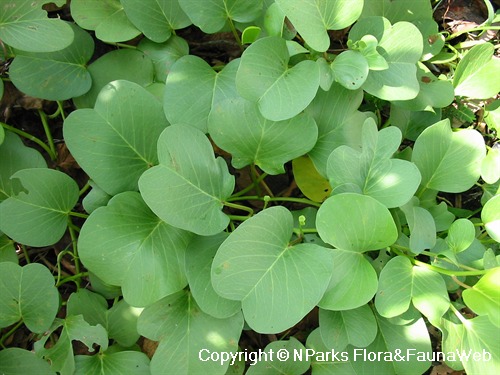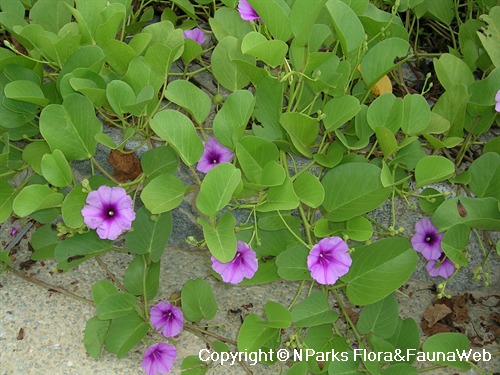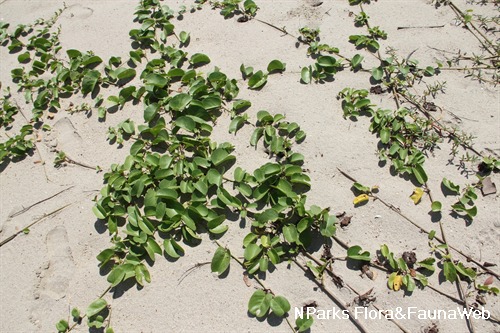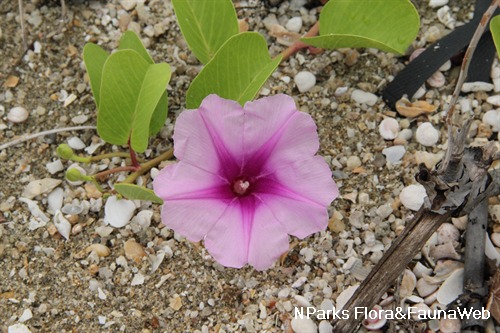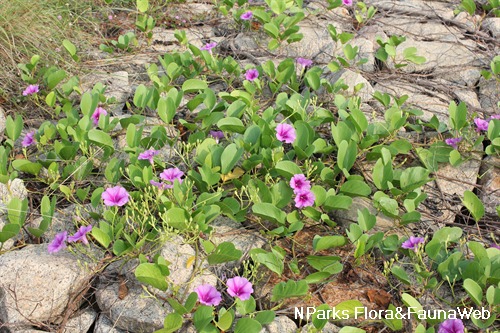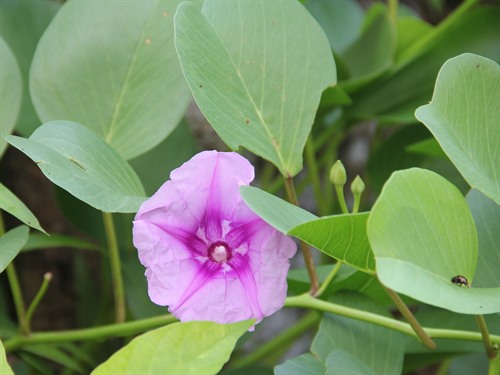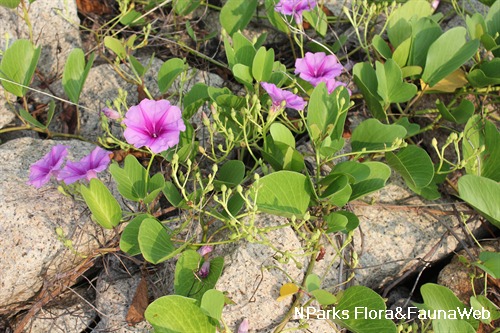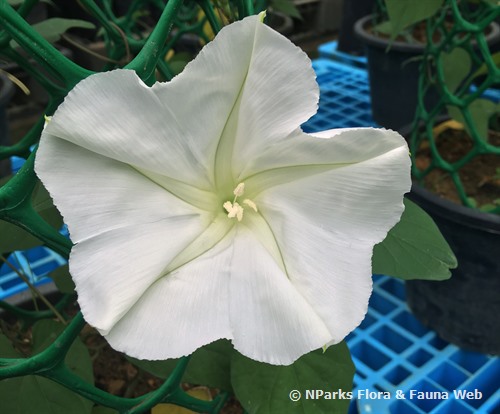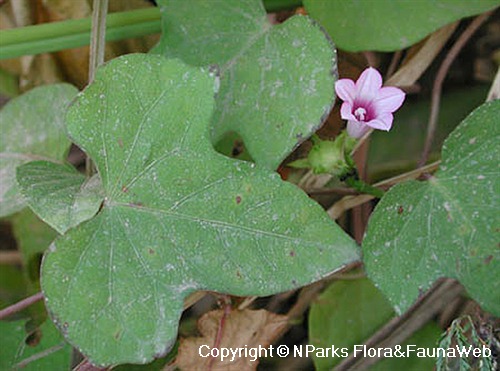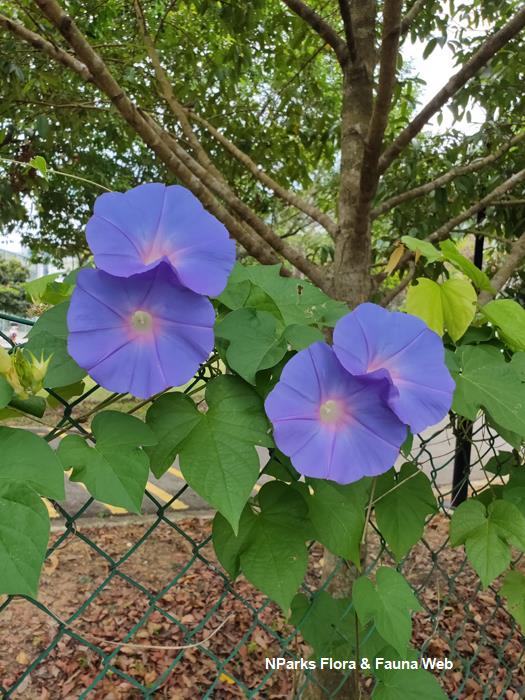.jpg)
Back
Ipomoea pes-caprae (L.) R.Br.
| Family Name: | Convolvulaceae |
| Synonyms: | Ipomoea pes-caprae subsp. brasiliensis, Ipomoea biloba |
| Common Name: | Beach Morning Glory, Railroad Vine, Sea Morning Glory, Tapak Kuda, Goat's Foot, Attukkal, 马鞍藤, 厚藤 |
Name
Classifications and Characteristics
| Plant Division | Angiosperms (Flowering Seed Plants) (Dicotyledon) |
|---|---|
| Plant Growth Form | Creeper |
| Lifespan (in Singapore) | Perennial |
| Mode of Nutrition | Autotrophic |
| Plant Shape | Irregular |
Biogeography
| Native Distribution | Pantropical; Somaliland, Tropical Asia, Sumatra, Malaysia, and Singapore |
|---|---|
| Native Habitat | Terrestrial (Coastal Forest, Disturbed Area / Open Ground), Shoreline (Sandy Beach) |
| Preferred Climate Zone | Tropical, Sub-Tropical / Monsoonal |
| Local Conservation Status | Native to Singapore (Least Concern (LC)) |
Description and Ethnobotany
| Growth Form | It is a latex-bearing, trailing creeper, with up to 30 m-long stems, and deep tap roots. |
|---|---|
| Foliage | Its long-stalked leaves have thick, fleshy leaf blades that are variable in shape, about 2.5–10 cm long and wide, each with a notched tip. |
| Flowers | Its stalked flowers are found 1–3 together from the leaf axils, and resemble those of the morning glory (Ipomoea cairica). Its flowers have pink, reddish-purple or violet petals that are joined into to a funnel-shaped structure. |
| Fruit | Its 4-seeded fruits are round, about 1.3 cm-wide capsules. Its black seeds are densely covered with brown hair, and 6–10 mm long. The seeds can float and are dispersed by the ocean currents. |
| Habitat | It grows on sandy shores, or adjacent to the granite walls of reclaimed sites, up to 600 m altitude. It occurs locally in the vicinity of Sungei Pang Sua, Changi Road, Pulau Ubin, and Pulau Tekong. It is commonly cultivated along sea walls, and reservoir embankments. |
| Cultivation | It is propagated by seed or stem cuttings. |
| Etymology | Greek ips, worm; Greek bomoios, similar to, meaning similar to a worm; Latin pes-caprae, foot of goat, referring to the shape of the species’ leaf blade that resembles the footprint of a goat. |
| Ethnobotanical Uses | Edible Plant Parts : Edible Leaves Food (Fruit or Vegetable) Medicinal: The juice squeezed from the plant is used in Malaysia to treat fish stings. The leaves are used in Indonesia to hasten the bursting of boils; sap from the young leaves are boiled in coconut oil and used to treat sores and ulcers; and the seeds, chewed with areca nut, sooth abdominal pains and cramps. In Philippines, the boiled leaves are used to treat rheumatism. |
Landscaping Features
| Landscaping | It is cultivated along windswept beaches as its deep tap-roots have the ability to bind sand. It also has attractive foliage and flowers, so grown as an ornamental creeper in coastal and inland sites on the the granite revetments of seawalls, reservoirs and canals. It seems to fizzle out after fruiting, so must be rejuvenated with regular pruning. |
|---|---|
| Desirable Plant Features | Ornamental Flowers, Ornamental Foliage |
| Landscape Uses | Coastal, General, Parks & Gardens, Beachfront / Shoreline, Groundcover |
Fauna, Pollination and Dispersal
| Seed or Spore Dispersal | Abiotic (Water, Explosive Dehiscence) |
|---|
Plant Care and Propagation
| Light Preference | Full Sun |
|---|---|
| Water Preference | Lots of Water, Moderate Water, Little Water |
| Plant Growth Rate | Fast |
| Rootzone Tolerance | Drought Tolerant, Moist Soils, Waterlogged Soils (Drains Site), Well-Drained Soils, Saline Soils / Salt Spray |
| Propagation Method | Seed, Stem Cutting |
Foliar
| Foliage Retention | Evergreen |
|---|---|
| Mature Foliage Colour(s) | Green |
| Foliar Type | Simple / Unifoliate |
| Foliar Arrangement Along Stem | Alternate |
| Foliar Attachment to Stem | Petiolate |
| Foliar Shape(s) | Non-Palm Foliage |
| Foliar Venation | Pinnate / Net |
| Foliar Margin | Entire |
| Leaf Area Index (LAI) for Green Plot Ratio | 4.5 (Shrub & Groundcover - Dicot) |
Floral (Angiosperm)
| Flower Colour(s) | Purple |
|---|---|
| Flower Location | Axillary |
| Flower Symmetry | Radial |
| Individual Flower Shape | Trumpet-shaped |
Fruit, Seed and Spore
| Fruit Type | Dehiscent Dry Fruit , Capsule |
Image Repository
Others
| Master ID | 135 |
|---|---|
| Species ID | 1431 |
| Flora Disclaimer | The information in this website has been compiled from reliable sources, such as reference works on medicinal plants. It is not a substitute for medical advice or treatment and NParks does not purport to provide any medical advice. Readers should always consult his/her physician before using or consuming a plant for medicinal purposes. |

.jpg)
